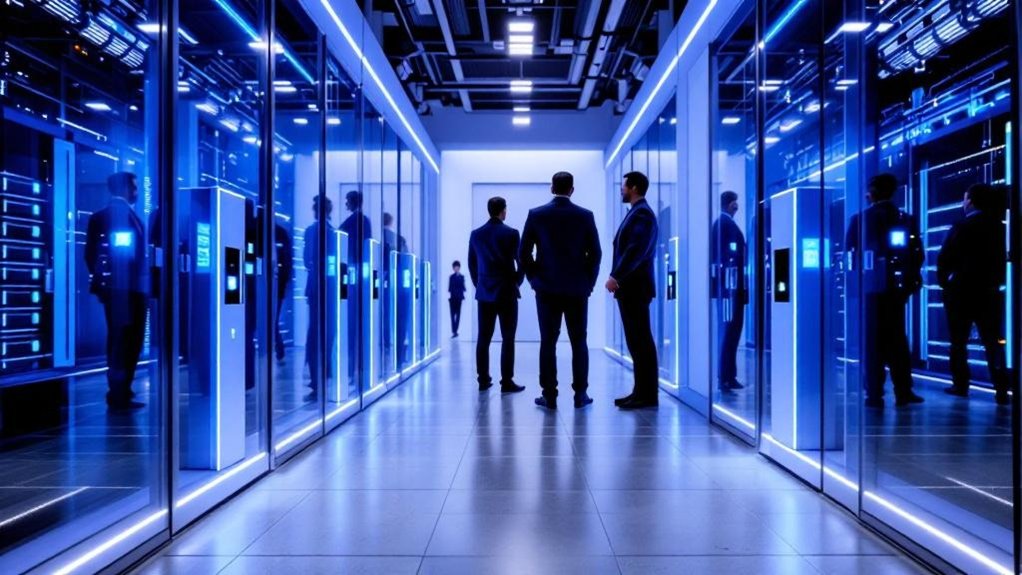Data center access control systems play a critical role in protecting sensitive information from unauthorized access. These systems integrate various mechanisms to regulate who can enter restricted areas. Understanding their structure and functionality is essential for maintaining security. However, the complexity of these systems often raises questions about their implementation and effectiveness. What are the key components that make these systems robust?
Understanding Access Control Systems
How do access control systems function within a data center environment? Access control systems serve as essential components in safeguarding the integrity and confidentiality of data housed within data centers. They regulate who can enter specific areas, ensuring that only authorized personnel gain access to sensitive equipment and information. These systems often employ various technologies, including biometric scanners, key cards, and security cameras, to monitor and control entry points. By maintaining a thorough log of access attempts, they provide valuable insights for audits and incident investigations. Additionally, integration with physical and digital security measures enhances overall protection, thereby mitigating risks associated with unauthorized access. Ultimately, efficient access control systems are crucial in upholding operational security and compliance within data centers. Furthermore, data management services ensure that access control measures are regularly updated and aligned with best practices for security.
Types of Access Control Mechanisms
While various access control mechanisms are employed in data centers, they can be broadly categorized into three main types: physical, logical, and administrative controls. Physical controls include barriers such as fences, locks, and security guards, which restrict unauthorized personnel from entering sensitive areas. Logical controls involve the use of software and digital authentication methods, including passwords, biometrics, and encryption, to protect data and systems from cyber threats. Administrative controls encompass policies and procedures that govern access, including user training, role-based access management, and compliance checks. Each type of control plays a vital role in ensuring the security of data centers, helping to mitigate risks associated with unauthorized access and data breaches. These mechanisms work in tandem to create a thorough security framework. Effective database management is crucial for maintaining the integrity and reliability of data centers.
Key Components of Access Control Systems
Access control systems are comprised of several key components that work collaboratively to guarantee secure entry and protection of sensitive information. The primary elements include access control hardware, such as keypads, card readers, and biometric scanners, which facilitate the verification of individuals seeking entry. Additionally, access control software manages permissions and logs entry attempts, ensuring that only authorized personnel can access specific areas. Another critical component is the central management system, which integrates hardware and software, allowing for real-time monitoring and adjustments. Finally, physical barriers like doors, gates, and locks play an essential role in preventing unauthorized access. Together, these components form a robust framework that enhances security and protects valuable data within a data center environment. Curious individuals responsible for managing these systems must continuously seek to understand emerging threats and technologies to maintain security effectiveness.
Authentication Methods for Access Control
Authentication methods for access control are essential in establishing a secure environment within data centers. These methods confirm the identity of individuals attempting to gain access, ensuring that only authorized personnel can enter sensitive areas. Common authentication techniques include password-based systems, where users provide unique passwords to verify their identity. Biometric systems, utilizing fingerprint or facial recognition, offer a higher level of security by relying on physical characteristics. Additionally, two-factor authentication (2FA) combines something the user knows (a password) with something they have (a mobile device), adding an extra layer of protection. Token-based systems also enhance security by generating temporary access codes. Each method serves to minimize unauthorized access and protect critical data and infrastructure. Furthermore, webinars provide a platform for data centers to reach out and discuss best practices in access control systems.
Role-Based Access Control (RBAC)
Role-Based Access Control (RBAC) is a system that restricts access to resources based on the roles assigned to users within an organization. This approach enhances security by ensuring that individuals only have access to the information and systems necessary for their job functions. Additionally, RBAC streamlines access management, making it easier to enforce policies and maintain compliance. Proper database management planning ensures that RBAC is effectively implemented and maintained throughout the organization.
Definition of RBAC
In modern data center security, Role-Based Access Control (RBAC) serves as a foundational framework for managing user permissions. RBAC is a method that assigns access rights based on the roles of individual users within an organization. Each role encompasses specific permissions that dictate what resources a user can access and what actions they can perform. This system streamlines the administration of user privileges by aligning them with job responsibilities, rather than managing permissions on a case-by-case basis. By categorizing users into roles, organizations can enforce security policies consistently, reduce the risk of unauthorized access, and simplify compliance with regulatory requirements. Overall, RBAC enhances security management by ensuring that users have the appropriate level of access based on their designated roles.
Benefits of RBAC
Implementing Role-Based Access Control (RBAC) offers several significant advantages for organizations aiming to enhance their data security. To begin with, RBAC streamlines the process of granting and managing user permissions, reducing administrative overhead. By assigning roles based on job functions, organizations can guarantee that employees have access only to the information necessary for their tasks, minimizing the risk of unauthorized access. Additionally, RBAC enhances compliance with regulatory requirements by providing clear access levels and tracking user activities. It also simplifies onboarding and offboarding processes, allowing for quicker adjustments to user access as roles change. Overall, RBAC not only strengthens security posture but also fosters a more efficient and organized approach to data access management within organizations.
Physical vs. Logical Access Control
Physical access control refers to the measures that restrict physical entry to data center facilities, ensuring that only authorized personnel can enter secure areas. In contrast, logical access control governs digital entry to systems and data, managing user permissions and authentication. Understanding both types of access control is essential for thorough data center security.
Definition of Physical Access
Access control systems are crucial for safeguarding sensitive environments, such as data centers, by managing who can physically enter a facility. Physical access refers to the measures implemented to restrict entry to authorized personnel only. This includes hardware components like locks, biometric scanners, and key cards, which guarantee that only vetted individuals gain access to critical areas. Physical access control is essential for preventing unauthorized entry, protecting valuable assets, and maintaining the integrity of operations. It encompasses various strategies, including visitor management, surveillance systems, and environmental controls. By establishing clear protocols and utilizing advanced technology, organizations can effectively mitigate risks associated with physical breaches, thereby enhancing the overall security posture of the data center.
Definition of Logical Access
Logical access control serves as a critical counterpart to physical access, focusing on managing permissions for digital resources and systems. This type of access control determines who can access specific software applications, databases, and files, ensuring that only authorized users can perform designated actions. Logical access is typically enforced through authentication mechanisms such as passwords, biometrics, and multi-factor authentication, which verify user identities before granting access. Additionally, roles and permissions are established to define the extent of access for various users, guiding what data and functions they can utilize. Together with physical access controls, logical access safeguards sensitive information, helping organizations maintain security and compliance with regulations while mitigating the risk of unauthorized data breaches.
Implementing Access Control Policies
Effective implementation of access control policies is essential for safeguarding data center environments. Organizations must establish clear guidelines that define user roles and responsibilities, ensuring that access is granted based on the principle of least privilege. This involves categorizing data and resources, determining who requires access, and setting restrictions accordingly. Policies should be documented and communicated effectively to all staff members, promoting awareness and compliance. Additionally, the integration of technology, such as biometric systems or smart cards, can enhance security measures. Regularly reviewing and updating access control policies is vital, as it allows organizations to adapt to evolving threats and changes within the workforce. Ultimately, a robust access control framework minimizes risk and protects sensitive information.
Monitoring and Auditing Access Control
Monitoring and auditing access control is a critical component in maintaining the integrity of data center security. These processes involve the continuous observation and evaluation of access logs and user activities to identify any unauthorized or anomalous behaviors. By employing sophisticated monitoring tools, data centers can track who accessed specific areas, at what times, and for how long. Regular audits help guarantee compliance with established access policies and highlight potential vulnerabilities in the system. Additionally, documenting these activities provides a clear trail for forensic analysis in case of security breaches. Overall, effective monitoring and auditing not only enhance security but also foster a culture of accountability among personnel accessing sensitive areas within the data center.
Integrating Access Control With Other Security Systems
Integrating access control with other security systems can lead to unified security management, streamlining the oversight of various protective measures. This synergy not only enhances the overall security framework but also improves threat detection capabilities. By combining these systems, organizations can respond more effectively to potential security breaches.
Unified Security Management
A thorough approach to security management emphasizes the importance of integrating access control systems with other security measures. Unified security management enables organizations to streamline their security protocols by consolidating various systems, such as surveillance cameras, intrusion detection, and alarm systems, into a single platform. This integration facilitates a detailed view of security events, allowing for quicker responses to potential threats. Additionally, it enhances operational efficiency by reducing the complexity of managing multiple, disparate systems. By utilizing centralized control, organizations can better allocate resources and improve communication among security personnel. Ultimately, unified security management supports a proactive security posture, ensuring that all elements of the security infrastructure work cohesively to protect critical assets within the data center environment.
Enhanced Threat Detection
Effective threat detection relies heavily on the seamless integration of access control systems with other security technologies. By connecting access control with surveillance cameras, intrusion detection systems, and alarm systems, organizations can create a thorough security framework. This integration allows for real-time monitoring and response, as alerts generated by one system can trigger actions in another. For instance, when unauthorized access is detected, video feeds can be automatically reviewed to assess the situation. Additionally, data analytics can identify patterns of suspicious activity across multiple systems, enhancing overall security posture. Ultimately, this interconnected approach improves situational awareness and allows security personnel to respond more effectively to potential threats, ensuring the protection of valuable assets within data centers.
Best Practices for Data Center Security
Ensuring robust security in data centers is essential for protecting sensitive information and maintaining operational integrity. Implementing a multi-layered security approach is critical, beginning with physical barriers such as secure fencing and surveillance cameras. Access control systems should enforce strict authentication measures, including biometric scanners and keycard systems, to limit entry to authorized personnel only. Regular audits and vulnerability assessments are significant for identifying potential weaknesses in security protocols. Additionally, staff training on security awareness can mitigate risks related to social engineering attacks. Data encryption and secure data transfer methods must be employed to safeguard sensitive information during storage and transmission. Finally, a thorough incident response plan should be in place to address any security breaches swiftly and effectively.
Frequently Asked Questions
How Do Access Control Systems Impact Data Center Efficiency?
Access control systems greatly enhance data center efficiency by streamlining entry processes, reducing unauthorized access, and allowing for better resource allocation. This leads to improved operational workflows and heightened security measures, ultimately benefiting overall performance.
What Are Common Challenges When Implementing Access Control Systems?
Common challenges when implementing access control systems include ensuring user compliance, integrating with existing infrastructure, managing costs, addressing scalability, and maintaining security against evolving threats. Organizations often require careful planning and continuous monitoring to overcome these obstacles effectively.
How Often Should Access Control Policies Be Reviewed?
Access control policies should be reviewed regularly, ideally annually, to guarantee they remain effective and relevant. This frequency allows organizations to adapt to evolving security threats and compliance requirements, ultimately safeguarding sensitive information and assets.
What Training Is Required for Staff Managing Access Control Systems?
Training for staff managing access control systems typically includes cybersecurity fundamentals, system-specific protocols, compliance regulations, and incident response strategies. Continuous education guarantees they remain updated on emerging threats and technologies impacting access control effectiveness.
Can Access Control Systems Be Integrated With Cloud Services?
Access control systems can indeed be integrated with cloud services, allowing for centralized management and monitoring. This integration enhances security measures while providing flexibility and scalability, accommodating the evolving needs of modern organizations.
Conclusion
In summary, data center access control systems play an essential role in protecting sensitive information and infrastructure from unauthorized access. By leveraging a combination of advanced technologies and thorough policies, these systems guarantee that only authorized personnel can enter restricted areas. Continuous monitoring and integration with other security measures enhance their effectiveness. Adhering to best practices further strengthens data center security, ultimately safeguarding critical assets and assuring compliance with regulatory standards.






